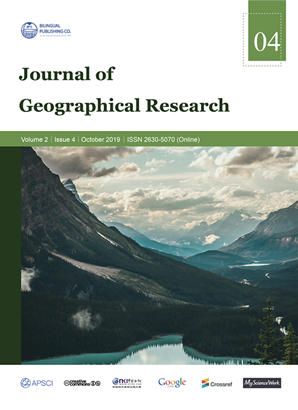-
1399
-
359
-
314
-
231
-
193
Effect of Precipitation Characteristics on Spatial and Temporal Variations of Landslide in Kermanshah Province in Iran
DOI:
https://doi.org/10.30564/jgr.v2i4.1818Abstract
Landslide can be defined as the mass movement of sloping slopes under the influence of mass gravity and its stimuli such as earthquakes, floods and flood plains. This phenomenon is one of the natural hazards that every year causes a lot of financial and financial losses in mountainous, rain-fed and seismic areas. Detection of time and the magnitude of land slides are necessary to understand the causes of landslide and to warn potential hazards. In this research, the amount of landslide displacement in Kermanshah province was evaluated by the characteristics of rainfall. To this end, a network of fixed points in and out of the slipping mass of 20 points was created to monitor the amount of displacement on different slip load users and the amount of displacement of each point in 5 time intervals using the Global Positioning System for two-dimensional GPS measurement. The results of the 511-day follow-up showed that the total horizontal displacement of the moving points in the 5 intervals measured at 1658 mm has a monthly displacement rate of 112 mm. Also, the total vertical displacement of moving points at the same time is 899 mm, with a monthly movement rate of 71 mm. Then, precipitation variances such as rainfall, rainfall, precipitation duration, maximum rainfall intensity in the intervals of 10, 20, 30 and 60 minutes and the average rainfall intensity were calculated and extracted for each of the 5 time periods. The drawing of the vectors of points on the topographic map of the area indicated that the direction of mass movement is in the direction of elevation gradient of the region. The results showed that only the precipitation severity with the landslide had a good correlation. The landslide movement had the highest correlation with average rainfall intensity (R = 0.85) and with maximum 30 minutes rainfall (R = 0.67), respectively, and other rainfall characteristics like amount, duration, and type of rainfall had not signifi cantly correlated with movement of landslides.Keywords:
Characteristics of precipitation; Effects; Landslide; Movement; GPSReferences
[1] Alcántara-Ayala, I., Sassa, K., Mikoš, M., Han, Q., Rhyner, J., Takara, K., Nishikawa, S., Rouhban, B., Briceño, S.. The 4th world landslide forum: landslide research and risk reduction for advancing the culture of living with natural hazards. International Journal of Disaster Risk Science, 2017, 8(4): 498-502.DOI: https://link.springer.com/article/10.1007/s13753-017-0139-4
[2] Bordoni, M., Meisina, C., Valentino, R., Lu, N., Bittelli, M., Chersich, S.. Hydrological factors affecting rainfall-induced shallow landslides: from the field monitoring to a simplified slope stability analysis. Engineering Geology, 2015, 193: 19-37.DOI: https://www.sciencedirect.com/science/article/pii/S0013795215001222
[3] Ciabatta, L., Massari, C., Brocca, L., Salciarini, D., Moramarco, T., Wagner, W., Tamagnini, C., April. A satellite-based distributed model for landslide risk assessment. In EGU General Assembly Conference Abstracts, 2018, 20: 8676.DOI: http://adsabs.harvard.edu/abs/2018EGUGA..20.8676C
[4] Hashemian, A.H., Rezaei, M., Kashefi, H., Pirsaheb, M., Kharajpour, H.. Trend step changes of seasonal and annual precipitation over Kermanshah during a 60-year period using non-parametric methods. Bioscience Biotechnology Research Communications, 2017, 10(4): 662-671.DOI: http://bbrc.in/bbrc/2018Oct%20-%20DecPDF/BBRC17_008.pdf
[5] Hong, H., Kornejady, A., Soltani, A., Termeh, S.V.R., Liu, J., Zhu, A.X., Ahmad, B.B., Wang, Y.. Landslide susceptibility assessment in the Anfu County, China: comparing different statistical and probabilistic models considering the new topo-hydrological factor (HAND). Earth Science Informatics, 2018, 11(4): 605-622.DOI: https://link.springer.com/article/10.1007/s12145-018-0352-8
[6] Huang, F.M., Wu, P., Ziggah, Y.Y.. GPS monitoring landslide deformation signal processing using time-series model. International Journal of Signal Processing, Image Processing and Pattern Recognition, 2016, 9(3): 321-332. https://www.researchgate.net/profile/Yao_Yevenyo_Ziggah/publication/299604868_GPS_Monitoring_Landslide_Deformation_Signal_Processing_using_Time_series_Model/links/5702a7aa08aea09bb1a3014b.pdf
[7] Krkač, M., Špoljarić, D., Bernat, S., Arbanas, S.M.. Method for prediction of landslide movements based on random forests. Landslides, 2017, 14(3): 947-960.DOI: https://link.springer.com/article/10.1007/s10346-016-0761-z
[8] Lin, M.L., Wu, Y.T., Wang, K.L., Hsieh, Y.M.. Monitoring of the Deep-seated Landslide using MEMS-a Case Study of Lantai Landslide, Taiwan. In EGU General Assembly Conference Abstracts, 2018, 20: 12531.DOI: http://adsabs.harvard.edu/abs/2018EGUGA..2012531L
[9] Melillo, M., Brunetti, M.T., Peruccacci, S., Gariano, S.L., Guzzetti, F.. Rainfall thresholds for the possible landslide occurrence in Sicily (Southern Italy) based on the automatic reconstruction of rainfall events. Landslides, 2016, 13(1): 165-172.DOI: https://link.springer.com/article/10.1007/s10346-015-0630-1
[10] Pham, B.T., Bui, D.T., Pham, H.V., Le, H.Q., Prakash, I., Dholakia, M.B.. Landslide hazard assessment using random subspace fuzzy rules based classifier ensemble and probability analysis of rainfall data: a case study at Mu Cang Chai District, Yen Bai Province (Viet Nam). Journal of the Indian Society of Remote Sensing, 2017, 45(4): 673-683.DOI: https://link.springer.com/article/10.1007/s12524-016-0620-3
[11] Rossi, M., Luciani, S., Valigi, D., Kirschbaum, D., Brunetti, M.T., Peruccacci, S., Guzzetti, F.. Statistical approaches for the definition of landslide rainfall thresholds and their uncertainty using rain gauge and satellite data. Geomorphology, 2017, 285: 16-27.DOI: https://www.sciencedirect.com/science/article/pii/S0169555X17300855
[12] Setiawan, H., Sassa, K., Takara, K., Miyagi, T., Fukuoka, H.. Initial pore pressure ratio in the earthquake triggered large-scale landslide near Aratozawa Dam in Miyagi Prefecture, Japan. Procedia Earth and Planetary Science, 2016, 16: 61-70.DOI: https://www.sciencedirect.com/science/article/pii/S1878522016300078
[13] Skofronick-Jackson, G., Huffman, G., Stocker, E., Petersen, W.. Successes with the Global Precipitation Measurement (GPM) Mission. In 2016 IEEE International Geoscience and Remote Sensing Symposium (IGARSS), IEEE, 2016: 3910-3912.DOI: https://ieeexplore.ieee.org/abstract/document/7730015/
[14] W. Yang, L. Shen, P. Shi. Mapping landslide risk of the world. In World Atlas of Natural Disaster Risk (pp. 57-66). Springer, Berlin, Heidelberg, 2015.DOI: https://link.springer.com/chap-ter/10.1007/978-3-662-45430-5_4
Downloads
How to Cite
Issue
Article Type
License
Copyright © 2020 Safieh Javadinejad, Rebwar Dara, Forough Jafary

This is an open access article under the Creative Commons Attribution-NonCommercial 4.0 International (CC BY-NC 4.0) License.




 Safieh Javadinejad
Safieh Javadinejad





